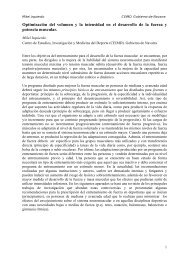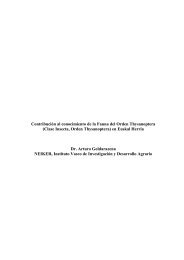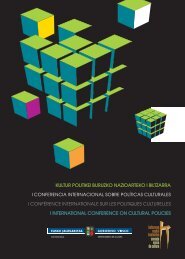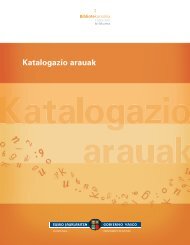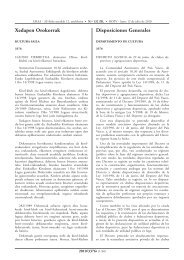The Basque Country (pdf, 4,3Mb) - Kultura Saila - Euskadi.net
The Basque Country (pdf, 4,3Mb) - Kultura Saila - Euskadi.net
The Basque Country (pdf, 4,3Mb) - Kultura Saila - Euskadi.net
Create successful ePaper yourself
Turn your PDF publications into a flip-book with our unique Google optimized e-Paper software.
50<br />
Sanctuary of Loiola.<br />
Azkoitia, Gipuzkoa.<br />
Plaza de la Constitución.<br />
Donostia-San Sebastián.<br />
Gothic art came early to Navarre and Iparralde (Cathedral of<br />
Bayonne) and somewhat later (late-fifteenth and early sixteenth<br />
centuries) but intensely to the other areas, accompanying the<br />
founding of the villas. Examples include the hospital-guesthouse<br />
of Orreaga- Roncesvalles, which houses the mausoleum of Sancho<br />
the Strong (1234), and the Cathedral of Santa María in Pamplona-<br />
Iruña, with Romanesque (1127) and Gothic (1394) elements,<br />
which holds the pantheon of Charles III and Leonor.<br />
In Araba there are many religious and civil examples of Gothic<br />
architecture. Of special interest are the eighth-century Cathedral<br />
of Santa María in Vitoria-Gasteiz– presently undergoing restoration<br />
with new technologies – Santa María in Vitoria-Gasteiz, and the<br />
churches of Laguardia, Agurain and Campezo.<br />
In Bizkaia, besides the Cathedral of Santiago in Bilbao, with its<br />
Puerta del Angel and Isabelline Gothic cloister, also worthy of<br />
mention are the Church of San Antón and the late Gothic (sixteenth<br />
century) Virgen de Begoña sanctuary in Bilbao, home of the patron<br />
saint of Bizkaia, “Amatxu de Begoña”. Other Gothic churches<br />
include San Severino in Balmaseda, the well -known Santa María<br />
in Lekeitio– with its splendid altarpiece in the florid Gothic style –<br />
and the churches of Ondarroa, Orduña and Gernika.<br />
Churches worth highlighting in Gipuzkoa are the churches of Santa María<br />
in Deba, San Vicente in Donostia, and Santa María in Hondarribia.<br />
Example of civil architecture include the “New Palace” in Olite, where<br />
Charles III and the Prince of Viana resided, the Luzea Tower in Zarautz,<br />
and the numerous civil Gothic buildings in Araba (the Ayala Complex<br />
in Kexaa-Quejana; the eighth-century Mendoza Tower near Vitoria-<br />
Gasteiz, the city which also contains the Portalón, the Doña Otxanda<br />
Tower (now the Museum of Natural Sciences), the Anda Tower and the<br />
Casa del Cordón Tower). In Bizkaia, the Muñatones de los Salazar Castle<br />
and the different tower-houses, some of which had their tops cut off<br />
at the orders of Henry IV and the Ercilla tower-house, which dominates<br />
the old port of Bermeo and now houses the Fishermenʼs Museum.<br />
At the beginning of the sixteenth century, coinciding with an important<br />
generation of stonesmiths, the Plateresque style, with magnificent<br />
examples, came to predominate over late Gothic. <strong>The</strong>re are some very<br />
noteworthy buildings in Gipuzkoa (University of Oñati, dating from<br />
1540, and the San Telmo convent in Donostia-San Sebastian), Bizkaia<br />
(the Colegiata de Ziortza cloister in Bolívar and the façade of the Begoña<br />
Basilica in Bilbao), and Araba (the palaces of Villa Suso, Montehermoso<br />
and Bendaña in Vitoria-Gasteiz) and in Navarre (the Monastery of Iratxe<br />
and the five bastions of the citadel in Pamplona-Iruña).<br />
In the second half of the sixteenth century, the Plateresque style evolved<br />
towards the so-called <strong>Basque</strong> Renaissance Gothic. Examples include the<br />
Church of San Pedro in Bergara and the Church of Nuestra Señora del<br />
Juncal in Irún. In the continental <strong>Basque</strong> <strong>Country</strong>, Gothic and Renaissance<br />
styles were combined, as seen in such place as the Elizabea castle, and<br />
in the curious three-sided bell towers of some churches in Zuberoa<br />
(Gotaine-Gotein) and in the Pamplona-Iruña citadel.<br />
Baroque and Neoclassical architecture<br />
<strong>The</strong> seventeenth century and much of the eighteenth century are<br />
predominated by the Baroque style, known for its curved lines<br />
and abundance of adornments.<br />
<strong>The</strong> urbanisation of Pamplona-Iruña and Bayonne took place<br />
during this period. In Iparralde a particular style arose, consisting<br />
of a single nave and three-sided bell tower, as seen in Donibane-<br />
Lohizune (St. Jean de Luz). In Gipuzkoa the splendid Basilica of<br />
Loiola and the Basilica of Santa María del Coro in Donostia-San<br />
Sebastian are the most important. In Bilbao, the churches of Santos<br />
Juanes and San Nicolás de Bari are outstanding; In Araba, the<br />
portico of the Church of San Juan de Agurain, and the altarpiece<br />
of the Church of San Miguel in Vitoria-Gasteiz; in Navarre, the<br />
Chapel of Santa Ana of the Tudela-Tutera Cathedral.<br />
In the late eighteenth century and throughout the ni<strong>net</strong>eenth, there<br />
was a return to classical shapes, where functionality prevailed.<br />
Some important architects visited us and left their mark, including<br />
Ventura Rodríguez (the Noain aqueduct, the façade of the Pamplona<br />
Cathedral) and Silvestre Pérez (Santa María in Bermeo, and the town<br />
council buildings of Donostia-San Sebastian, Durango and Bermeo).<br />
Seventeenth through ni<strong>net</strong>eenth century urban planning was of<br />
high quality. Fine examples of Neoclassical architecture can be<br />
seen at the Plaza Nueva town square in Vitoria-Gasteiz, designed by<br />
Justo Antonio de Olaguibel, as well as the Palacio de la Diputación<br />
(seat of the Provincial Council),<br />
Los Arquillos and Plaza España.<br />
In Donostia-San Sebastian,<br />
examples include the Palacio<br />
de la Diputación and the<br />
Plaza de la Constitución;<br />
in Bilbao, the Plaza Nueva;<br />
in Gernika, the Casa de<br />
Juntas (Assembly house);<br />
and Pamplona-Iruña, the<br />
façade of the Cathedral<br />
of Santa María and the<br />
Palace of Navarre.<br />
Gothic Cathedral of<br />
Vitoria-Gasteiz designed<br />
“Open for Construction,” a<br />
plan featuring state-of-therestoration<br />
techniques and<br />
guided tours open to the<br />
public.




